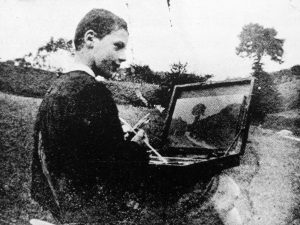
The Palais de l’Industrie, where the event took place. Photo by Édouard Baldus (this file is made available under the Creative Commons CC0 1.0 Universal Public Domain Dedication).
Estimated reading time: 9 minutes. Contains 1,312 words
ArtFacts.Net’s (AFN) goal is to collect information about all exhibitions since the ‘Salon des Refuges’, 1863 in Paris. The Salon des Refuges is considered the birthplace of today’s art market. Before 1863 art was first and foremost used to materialize god’s own infinitive greatness. Later when power shifted towards secular aristocratic families art became a symbolic representation and manifestation of the patriarch’s wealth and power.
During the era of ‘enlightenment’– the Renaissance — experimental research and freedom of thought evolved with the decline of the church’s constitutional power. The ‘individualists’ (the businessmen) slowly but steadily gained more social influence. It was these businessmen that were eventually responsible for a radical shift in the purpose of art.
Inventions, industrialization and marketing led to the creation of automated image capturing — known as photography. A photo, done in minutes, could carry all the social functions a painting had historically served:
- materialization of social status
- documentation and information
- education and guidance
This technological development meant that certain artistic skills lost their market value. This forced artists to instead focus their attention on the materialization of the their own subjectivity, giving birth to the ‘individualist’. From this movement a group emerged who were searching the deeper inner values of art (distinct from craft), known as the Impressionists.

Robert Antoine Pinchon 1898, en plein air, painting Le chemin, oil on canvas, 22 x 32 cm
Forced out of their studios by photographers and film-makers, the artists took advantage of the new means of transport ‘the train’ to leave Paris and to paint plein-air. Being in the countryside on their own — without any commission or order to visualize god’s vastness, aristocratic power or a merchants thirst for image — they were able to visualize their own individuality.
The Impressionists avantgarde visual creations struck the public eye. They provided an enriching alternative to the ‘photographic’ painting style that the public had become accustomed to. Threatened by the rise in new subjective and lense-less paintings, official juries often disqualified these artworks from the popular public viewing contests of their time, the Salons. It was Napoleon III of the Liberal Empire who pardoned the refused by sponsoring the ‘Salon des Refuses‘ in 1863. The Impressionists were then quickly picked up by a new emerging power, the American businessmen of the second industrial revolution.
Ever since that time new styles of ‘individuality’ followed one-by-one, differentiating between generations. Such as; Fauvism, Expressionism, Cubism, Dadaism, Bauhaus, Surrealism, Abstract Expressionism, Op-Art, Pop-Art, Minimalism, Performance Art, Land Art, Hard Edge, Conceptual Art, Graffiti, Street Art, Young-British-Art, Video Art, Net Art etc.
The aim of ArtFacts.Net is to better understand aesthetic variations and identify key artists that ignite each era and style.
Art history is exhibition history. The spectators understanding of art is nurtured by viewing experience. Through the means of an art exhibition we can participate in the development of modern art.
 Market data has traditionally been collected through auction results. Thirty years ago Englishman, Duncan Hislop authored the Art Sales Index which was the first computer enhanced systematic catalogue of art prizes (now owned by Blouin Media). 10 years later — in the late 90s — Jianping Mei and Michael Moses created their index for repeated sales, Mei Moses Art Indice (now owned by Sotheby’s). At the turn of the century numerous auction price databases were established, most of them on-line. As a result, price analysis is now an integral part of purchase decisions worldwide.
Market data has traditionally been collected through auction results. Thirty years ago Englishman, Duncan Hislop authored the Art Sales Index which was the first computer enhanced systematic catalogue of art prizes (now owned by Blouin Media). 10 years later — in the late 90s — Jianping Mei and Michael Moses created their index for repeated sales, Mei Moses Art Indice (now owned by Sotheby’s). At the turn of the century numerous auction price databases were established, most of them on-line. As a result, price analysis is now an integral part of purchase decisions worldwide.
Auction pre-sale shows function as exhibitions as well, but they are not the competitive playground where new styles are born because they only represent a tiny fraction of contemporaries art production. Price analysis uses only a small part of the industry to influence major decision making.
Auction price analysis is based on equalizing different art works from one artist to generate an overall value of the artists production.The group of artists with artworks in repeating sales analysis is within 1% (400 artists), even smaller than the group of artists used in auction price analysis (40,000 artists). This method leaves out many artists working with technology like, digital video, software and even artists working with classic media like, Land or Body art.
The secondary art market has traditionally been the playground for auction houses or art dealers. Through the internet secondary marketplaces are proliferating on-line.
The art market is widening and the traditional separation of first and secondary market is being destabilised.
The division into primary and secondary markets helped mainly two groups of merchants to manifest their role as aesthetic trend setters, galleries for the primary newly produced art and the auction houses for the secondary ‘used’ art market.
The primary art market was basically structured like the football league where the artists are the players and the galleries are the clubs. The galleries are structured in leagues and better embedded galleries try to take the shooting stars away from the smaller galleries.
International players among these galleries place their artists world wide in leading local galleries to create an international story – through exhibitions and media coverage – of their ‘heroes’.
The auction houses come into play when it comes to reselling works of the ‘heroes’. In this market segment the focus is not on artist branding but on the branding of masterpieces (single works of art). These masterpieces will come into the repeated sales index and effectively function as an aesthetic currency. The aim of merchants in the primary and secondary market is to strategically built up, on the one hand art masters and on the other hand art masterpieces.

Habib Asal – “The source of this work is the artist ranking on www.artfacts.net. This portal is an international online gallery and museum guide for modern, contemporary and young art. From a certain date the names of the artists are written on museum walls. The surface of the available space determines the amount of names that can be written down.”
This two-step market structure acts as a funnel to extract a very small number of masters and an even smaller number of masterpieces. Potential customers are forced into the position of a spectator as they watch only those who are selected to play while the majority of artists sit on the sidelines.
The collaborative internet is now enabling producers (the artists) to better market themselves and navigate their own success, as well as consumers to create their own ‘secondary market’. This is where ArtFacts.Net fits in. As an online platform, ArtFacts.Net uses the internet to overcome some of the limitations of the art market, taking advantage of:
- the long tail: The long tail basically means the possibility to create sustainable niche markets because consumers can be reached world wide.
- the social network: The participatory element of the internet allows users a two-way communication. The publisher is no longer just content provide. The publisher is a communication platform provider.
- Big data: The sheer unlimited data storing power provided by modern cloud computing. The collection, structuring and statistical analysis of huge amounts of data enables deeper insights and fast reaction to market developments
With its ‘Artist Ranking’ (first published autumn 2004) AFN put a quantification focus on all artists showing their work in public.
By measuring the reputation of any museum, gallery or biennial worldwide AFN assigns a reputation value to each artist participating in shows organized by one of these institutional bodies. The summarized reputation points give each artist a unique rank, enabling comparison between distinct artist career paths.
AFN with its powerful exhibition database has already proven that big data in the art market can achieve transparency and greater access.
Producers, merchants and consumers alike are using the Artist Ranking System for decision making. The Ranking represents the long tail providing economic information for niche artists that was never before available.
Best wishes

Marek Claassen, Founder and Managing Director ArtFacts.Net Group
Article written in 2004
